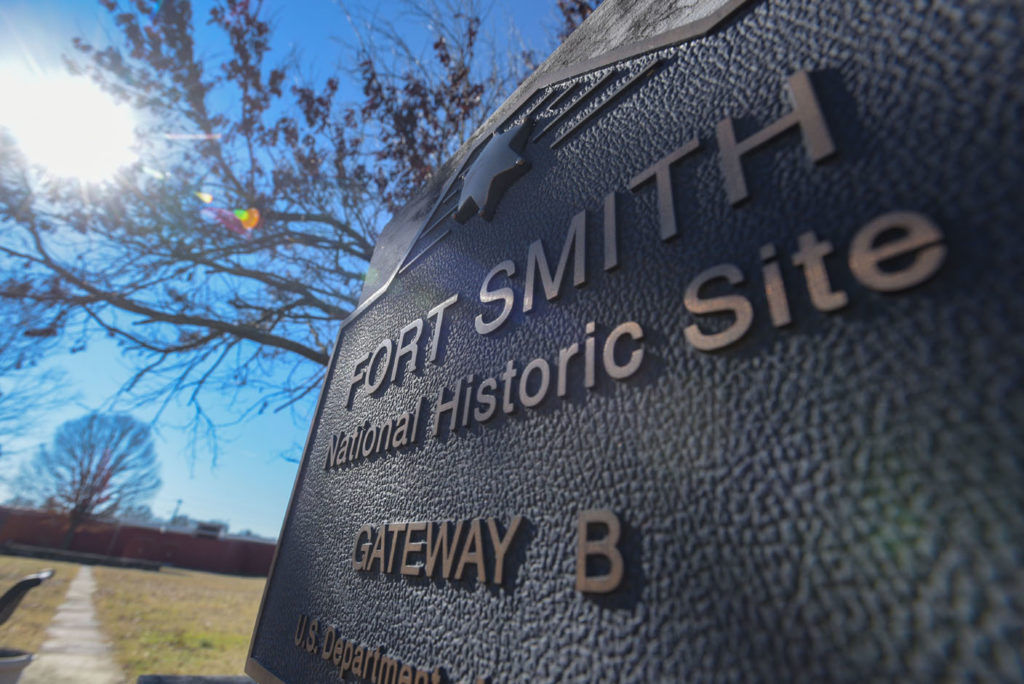Thomas Saccente
tsaccente@nwaonline.com
Staff at the Fort Smith National Historic Site are optimistic about 2022 after being closed for the majority of the past two years.
Nissa Mondahl, chief of interpretation for the National Historic Site, says officials at the approximately 38-acre park were excited to be able to open the visitor center and museum late last year. The site closed in March 2020 after the emergence of the covid-19 pandemic, and extremely cold weather the following February froze a sprinkler head and caused water damage to the building.
However, Mondahl says there’s more to do, and everybody is ready to go.

“We’ve got a lot of programming that we’re working on, a lot of things,” Mondahl says. “We’re trying to really vary our programming so there’s a little bit for everybody.”
Lisa Conard cq Frost, superintendent for the National Historic Site, says the site will maintain its standard of visitor services during 2022 and hopes people will visit and learn the history it has to offer.
The site at 301 Parker Ave. typically gets visitors from across America and other countries, according to Frost.
Mondahl says the National Historic Site covers about 80 years of early Fort Smith history, which she described as “incredibly varied.” This history started Christmas Day 1817, when the Army settled at what became known as Belle Point, a bluff overlooking the Arkansas and Poteau rivers, after being sent to help defuse tensions between two Native American tribes, the Osage and the Cherokee.
“It’s not until much later, or a bit later, that we have official Indian removal policies, but the U.S. government at that point in time had started encouraging some of the eastern tribes to move into what becomes known as Indian Territory,” Mondahl says.
This military presence continued until the Army abandoned Fort Smith and established Fort Gibson in the Indian Territory in April 1824, an exhibit at the Historic Site states. However, Arkansas became a state in 1836, and Congress authorized a second Fort Smith 100 paces to the east of the first in 1838. The Army moved into the barracks of the new facility in 1846, four years after the town was incorporated.
Mondahl says the fort also served as a stop for Native Americans on the Trail of Tears.
The Army went on to abandon Fort Smith after the outbreak of the Civil War in 1861, according to another Historic Site exhibit. Union forces under the command of Gen. James Blunt took back the post from the Confederacy unopposed in 1863, the Encyclopedia of Arkansas states.

Although the second fort closed in 1871, Fort Smith became the seat of the U.S. Court for the Western District of Arkansas that same year, an exhibit states. Its jurisdiction included the Indian Territory. Isaac Parker, a former U.S. congressman from Missouri, was appointed judge and presided over the court from 1875 until his death in 1896. The Encyclopedia of Arkansas states Parker tried more than 13,000 cases, with 79 men being hanged for capital crimes.
Mondahl notes despite his well-known and influential moniker, the “Hanging Judge,” it’s been said Parker didn’t believe in the death penalty. Both he and his wife, Mary, were also very active in the Fort Smith community.
A new federal courthouse was opened on Sixth Street in Fort Smith in 1890, according to the museum. The Western District of Arkansas also lost its jurisdiction over the Indian Territory in 1896. Mondahl says one of the jail areas at the National Historic Site remained in use until 1917, when it was officially abandoned.
Mondahl says the National Historic Site offers visitors a chance to see some of the original structures from its past. This includes the oldest building in Fort Smith, the site’s commissary building, which was completed in 1838.
Among the site’s other attractions are the first fort site at Belle Point, Parker’s courtroom, a reconstruction of the gallows, two jail areas, including one dubbed “Hell on the Border,” and exhibits showcasing each of the site’s various phases and their respective historical contexts. There are also trails, including some that go down by the Arkansas River.
Mondahl says she believes Fort Smith as people know it would not be where it is had the Army not come to the area.
“There’re so many influences that came right here, partly because of geography, partly because of other things that were already here, and a lot of that history still is here,” Mondahl says. “We still have that in our memory.”
FAQ
Fort Smith National Historic Site
WHEN — 9 a.m.-5 p.m. daily; the park grounds and trails are open half an hour before sunrise to half an hour after sunset.
WHERE — 301 Parker Ave. in Fort Smith
COST — $10; children 15 and younger free
INFO — 783-3961 or https://www.nps.gov/fosm



